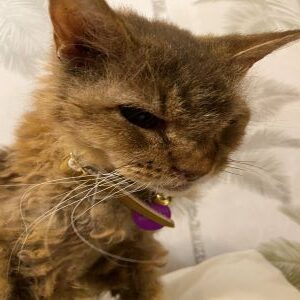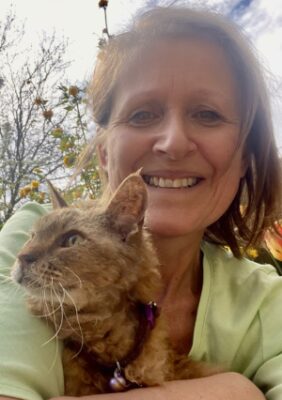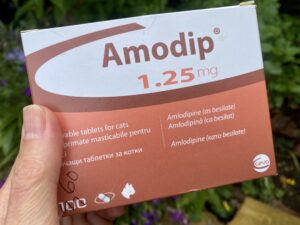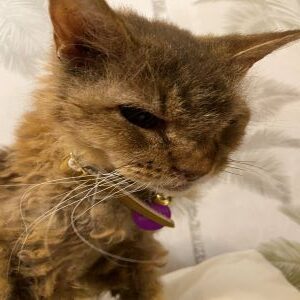Felines are known for their sharp senses, hunting ability and independence, but like all animals, a cat can develop health issues that can lead to partial or total blindness. Blindness can happen gradually because of age or suddenly from high blood pressure.
High blood pressure is also known as hypertension and affects any age, particularly senior or geriatric cats. In general, blood pressure can increase when a cat is stressed visiting a veterinary practice, a journey or a holidaying in a cattery for the first time. Excessively high blood pressure is dangerous for a cat and will be a long-term health issue, which is reduced with the help of medication and regular blood pressure monitoring.
Secondary Hypertension:
A cat has high blood pressure from an underlying condition: chronic kidney disease, and/or hyperthyroidism, and/or some heart conditions.
Primary or Idiopathic Hypertension:
A cat has high blood pressure from unknown causes.
Tabitha –
Tabitha went blind suddenly and at the consultation, she was diagnosed with idiopathic hypertension (high blood pressure) in March 2022. Her blood pressure reading was 240mm Hg, danger level.
“…hypertension is often known as a ‘silent killer.”
CatBloodPressure website
I am always observant of my pets, especially as I give a home to poorly animals, so I recognised a change in Tabitha. However, it coincided with a house move and boxes piled up in the lounge, and I thought perhaps she was creeping about because of the chaos. Even so, I booked an appointment with her vet but had to wait a week.
Tabitha showed these behavioural changes –
- Bumping into new objects that weren’t usually there
- Head hung low
- Following the walls instead of walking across the room
- Slight crouch walk
- A faeces accident on the floor
- Two urine accidents on a rug
- Suddenly unsure about walking down the stairs and had to be re-taught
Understanding high blood pressure in cats

Over time, hypertension can cause severe damage to an untreated cat:
- Eyes – high blood pressure causes bleeding in the eye chamber. The retinal can swell and become detached, which can cause issues with vision, including eyesight, and pupils dilate in the light instead of just darkness. A vet will check a feline’s eyes to determine the above and any partial sight or complete blindness
- Heart – the tissues of the heart may thicken over time and lead to congestive heart failure. When blood pressure is high, the heart pumps blood with more effort, giving a negative effect on the muscle belonging to a major heart chamber. Signs of heart issues are lethargy and/or breathlessness
- Kidneys – If high blood pressure is caused by chronic kidney failure, the health of the kidneys will gradually deteriorate. If idiopathic, high blood pressure can cause kidney failure
- Nervous system and the brain – changes in behaviour, seizures, difficulties with balance or a drunken walk, confusion similar to dementia or a coma can develop with bleeding into the brain or nervous system
At first, or at all, signs of blindness, change in behaviour, or stress may be unnoticeable. Still, if you suspect sudden blindness, it’s vital to make the appointment with a vet as a priority and to explain sudden blindness has happened. A veterinarian will conduct an essential but basic eye examination with appropriate equipment. A cat may suffer organ failure or die without veterinary intervention and medication.
Dangerous and safe blood pressure ranges for a cats
- 200mm Hg and above is dangerous and veterinary intervention is vital
- 180mm Hg and over is regarded as high blood pressure
- 160mm Hg is regarded as normal blood pressure
Tabitha –
Tabitha was given a blood pressure test immediately.
The results:
- Blood pressure 240mm Hg
- Bleeding into one eye
- Sight limited in both eyes but not complete blindness
- Blood test to assess kidney disease, and hyperthyroidism (overactive thyroid gland)
- Because bloods showed she didn’t have kidney problems, her vet did not express her urine for further testing
Diagnosis by the vet: Idiopathic Hypertension (high blood pressure) and was prescribed 1.25mg Amodip.
Amodip is a calcium channel blocker for cats with high blood pressure, and it aims to prevent damage to the brain, nervous system, heart, kidneys and eyes.
Symptoms of high blood pressure in cats

Felines with high blood pressure may not show initial symptoms until the condition progresses and, from this point, may begin to exhibit different symptoms. High blood pressure is also irreversible but can be managed.
The following are the most common symptoms of high blood pressure:
- Disorientation and confusion in familiar surroundings
- Loss of appetite
- Weight loss
- Increased thirst and urination
- Blood visible in the eye
- Dilated pupils (black area of the eye) and don’t change (to black slits)
- Sudden blindness or partial sight loss
- Seizures
Other changes in behaviour to look for are:
- Overgrooming
- Stumbling down steps and reluctance to walk down stairs
- Bumping into familiar furniture or newly placed objects
- Walking in a crouch with head hung low
- Easily startled unless deaf
A cat may experience a personality change when blood pressure is high:
- Withdrawal
- Brain fog, so a feline may be unresponsive instead of alert
- Depressed
- Deeply lethargic and inactive
- Weepy eyes
When a human experiences high blood pressure, headaches develop, and a cat may suffer the same, although it is unconfirmed.
Tabitha –
Her weight averaged 3.5kg to 3.7kg, but when she lost her eyesight, Tabitha’s weight plummeted to 2.70kg and she pulled out half her body fur. I think both happened from confusion, shock and stress. It is worth noting that a cat will overgroom as a stress relief. She stopped purring, but once the medication got in her system and her blood pressure began decreasing, the overgrooming stopped, and she started to purr and became more active. By her second appointment, her weight had increased to 2.76kg, which her vet was happy with.
However, her blood pressure increased again.
Diagnosis by the vet: Blood tests never revealed the cause of the blood pressure and her condition remains idiopathic.
Blindness in cats and high blood pressure
One of the common and worrying symptoms of high blood pressure is sudden or partial sight loss. With limited or complete blindness, it can be traumatic for a cat and challenging to adjust to a life without sudden sight. With a gradual deterioration of age-related eyesight, a cat has time to adjust. A cat with sudden sight problems resulting from high blood pressure needs longer to adjust. This can be weeks.
Help a blind cat by keeping furniture and belongings must be kept in the same place:
Like dementia, keep the following in the same place to help your kitty transition without sight. Also, if your cat is of geriatric age, dementia may develop so it is important to be aware of the signs. Tabitha has the start of dementia and for another cat I used Aktivait but because of costs, Tabitha has a supplement called RenewMe.
- Food and water bowls
- Bed
- Litter tray
- Add extra litter trays to reduce difficulties in finding the trays
- If a feline sleeps with you, put a stool or solid box beside a bedside cupboard
- Furniture
- If your feline sleeps on the sofa or armchair, put a stool or solid box in front
- Garden activity will need to be monitored
- Ensure a cat cannot escape the garden, as it will be a target for predators or a vehicle
High blood pressure happens when pressure is increased in the eye’s blood vessels, causing damage to the retina. The retina is the part of the eye that senses light and subsequently sends signals to the brain.
Tabitha –
- 1st visit to see the vet – Tabitha had bleeding in one eye (seen by the vet) and her blood pressure measurement was 240mm Hg
- 2nd visit two weeks later – blood pressure was 190mm Hg and the bleeding in the eye was gone
- 3rd visit two weeks after the second – Tabitha’s blood pressure had increased to 230mm Hg with bleeding behind both eyes
Diagnosing high blood pressure in cats
Again, my vet suspected high blood pressure when I mentioned Tabitha seemed to lose eyesight overnight. We now understand that hyperthyroidism and kidney failure can cause high blood pressure. However, when my other cats developed these two conditions, neither had annual blood pressure checks, and I never associated one with the other.
To confirm a diagnosis of high blood pressure, a veterinary will measure a cat’s blood pressure using a machine called a sphygmomanometer (blood pressure monitor). The device is non-invasive. A nurse or veterinarian will place a miniature cuff around a cat’s leg or tail and inflate it to stop blood flow temporarily. Gradually, the pressure is released. From this action, a veterinarian or nurse will make an audio assessment from blood moving through the artery to determine diastolic and systolic blood pressure.
Diastolic:
Normal diastolic in cats (and dogs) is 60mm Hg to 90mm Hg
Systolic:
Normal systolic blood pressure in cats (and dogs) is 120mm Hg to 160 mm Hg
Blood pressure monitors are available online, but a qualified veterinarian needs to measure blood pressure and prescribe life-saving medication. A vet will not prescribe medication based on a personal reading.
Tabitha’s first vet wanted her blood pressure to decrease to 140mm Hg but another vet has been happy with blood pressure at 180mm Hg.
Related articles:
- Buy medication with a prescription from a vet – save money on Amodip
- Watch the Video: heated pet bed – older pets need warmth
- Calming sprays and wipes – helping your cat with relaxation
- TabCat cat tracker – takes you to your cat via audio and visual signals
- Tractive mini CAT tracker – locate your cat (or dog) using an app or web browser
Treatment for high blood pressure in cats

Treatment for high blood pressure will depend on whether a feline has kidney or hyperthyroidism. From Tabitha’s point as idiopathic, she was prescribed Amodip, formulated to decrease blood pressure. At first, she had half a tablet, then one tablet daily.
Expect fortnightly blood pressure measuring appointments to begin with. When Tabitha’s blood pressure dropped between 165mm Hg – 180mm Hg, appointments changed to every three months, with medication prescribed alongside blood pressure monitoring. In 2022 I paid between £65 to £70 for a blood pressure reading and sometimes extra for a consultation.
Ask for the same vet because one vet will be happy with, for example, a reading of 180mm Hg, and another won’t and want the blood pressure to drop. Some vets suggest keeping a cat at the practice for a few hours before blood pressure is taken to settle them. When Tabitha stayed in, her reading was 150 mm Hg. It increased to 180mm Hg when she did not stay in. Don’t forget, veterinarian visits, car trips etc, will cause blood pressure to increase slightly anyway.
In the early days, bloods will be taken to determine kidney failure or hyperthyroidism if not already known. Tabitha’s results were always negative, and a year on, I declined further blood tests.
The outcome for cats with high blood pressure
Medication and monitoring are for life.
The prognosis for sight recovery is poor, and high blood pressure and the damage are irreversible. However, there is a chance that blood pressure can be lowered, so it is essential to get your pet to a vet as soon as possible.
A cat will need the understanding of its owner. Give your cat time to become familiar again with its home, and help by keeping everything in the same place. Never scold your cat because of an accident. It takes time, but a cat will find its way around again and locate the litter tray.
Tabitha – May 2023
Tabitha is blind in her right eye, with a bit of sight in her left eye. We have moved home three times in exactly 12 months because of circumstances out of our control. She had accidents on the floor for the first few weeks at each house but eventually found the three litter trays I set up and kept in the same place. Food and water bowls stay in the same place. Her bed steps, if possible, stay at the bottom left side of the bed, and her glass of water sits on my bedside cupboard. In the first and second house we moved to, I tied flattened cardboard boxes to the balustrade because, in the first house, she walked between the spindles and fell several feet down onto the stairs. She survived without injury.
Because she has sight in the left eye rather than the right, Tabitha always turns left and sometimes finds her chosen route blocked. On walkabout, she surveys her surroundings by feel and scent, but if she constantly walks around in the same area, it means she cannot find her way out. Tabitha is deaf too, and I help her ‘training’ with vibration against the floor. I lightly bang or scrape at the floor, bed, chair etc, with my fingers and I believe she guesses where she is by the surface (bedding, bed stairs, non-slip mat on the bedside cupboard etc).
She has supervised garden time too.
Tabitha has Amodip daily, and to reduce costs, I buy each prescription with 6 months of tablets prescribed and purchase medication one month at a time at VioVet. Prices will vary so check Animeddirect and Pets Drug Online too.
Reading various veterinary websites, it is advised that cats under 7-years-old should have blood pressure measured yearly so any potential condition can be detected early. From 7-years-old, the test should be twice a year. I was never offered this but Mum was for her 16-year-old cat, and the high blood pressure was caught early. Gonzo was prescribed Amodip and has a daily half-tablet daily. He has secondary hypertension (hyperthyroidism) and still has his eyesight.
Related questions:
Is sudden blindness only related to hypertension?
The following can cause unexplained and sudden blindness:
- Infections in the body
- Brain or nerve tumours
- Cancer in or near the eye
- Uveitis is inflammation in the middle layer of the eye
- Glaucoma
- Neurological disease
- Infection within the eye
- Antifreeze
- Cataracts
- Overdose of prescribed medication – follow the dosage your vet states
- Head trauma – my cat Joey was in a catfight and hit his head. It caused blindness and seizures
- Unknown causes
Again, seek urgent veterinary advice if you notice odd behaviour in your cat or dog.
Disclaimer
I am not a veterinary professional. This article does not give a diagnosis but brings awareness from my experience of having a cat with hypertension. If you have any concerns about your pet, please get in touch with your vet directly.
Poppys Pets is a participant in Awin and Amazon Associate affiliate programs which compensates me for referring traffic. It is of no extra cost to you and if thinking of buying a product, please consider using my link. It\'ll earn Poppy\'s Pets a few pennies to continue to this website. Only a selection of articles and videos on this website and YouTube channel contains affiliate links. Further information: Disclaimer and Privacy Policy
Poppy’s Pets has a column in the Withernsea & District Community News


